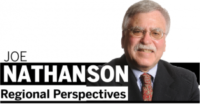
On June 15, Gov. Wes Moore, together with federal, state and local officials, business leaders, and community representatives standing at the West Baltimore MARC station, announced his commitment to building the Red Line, the east-west transit service through the center of the Baltimore region. This represented a restart of a process that was terminated by a decision of then-Gov. Larry Hogan in 2015.
To gain a sense of what moving forward would now entail, I had a chance to speak by phone
with Joe McAndrew, an assistant secretary at Maryland Department of Transportation, along
with Holly Arnold, administrator of the Maryland Transit Administration. Their goal is to come
up with decisions about the route alignment, station locations, mode (e.g., bus rapid transit,
light rail) and arrive at a “locally preferred alternative” for submission to the federal
government by the end of calendar 2024. This timeline would enable Maryland to make its
claim for so-called New Starts funding in the federal fiscal year 2026 budget.
Without them saying so, the heavy rail option (subway) is off the table, seemingly out of cost
concerns. But there are many other thorny issues to be addressed, as became clear while I
subsequently listened to Kate Sylvester, MTA’s deputy administrator with responsibility for
planning, and Kimiya Darrell, leading the challenging work on stakeholder engagement, during a
virtual meeting of Transit Choices, a local advocacy group.
Even before the relaunch of the Red Line project, MTA had engaged in another exploration of
ways to satisfy demand for east-west transit service. The 2022 East-West Transit Corridor
Feasibility Study offered the community seven alternatives for connecting either the Social
Security Administration complex or Ellicott City on the west to Bayview or other possible
terminal points on the east side. The study, providing permutations of both mode and route
alignment, confirmed that there is travel demand worthy of new investment in transit, but it
did not land on a preferred alternative.
Supported by this new body of knowledge, the Red Line study is running alongside several
other planning initiatives that address central Baltimore’s mobility needs. These include:
1. RAISE Baltimore, a $50 million project centered on the North Avenue corridor, now in the
design phase, will create transit priority treatments, including dedicated bus lanes, pedestrian
safety measures and provide improved community connectivity.
2. West Baltimore United, part of a national commitment to “reconnecting communities.” In
this case, the effort is responding to those communities torn apart more than 50 years ago by
the construction of the notorious “Highway to Nowhere.” The hope here is that, while
addressing transportation issues, there will be opportunities for transit-oriented development
and to generate re-investment in these low-income communities.
3. East Baltimore County Access Study to consider ways of serving new job centers in the
southeastern portion of the county, most notably the estimated 10,000 jobs now at TradePoint
Atlantic.
4. There is also the reality of the new Frederick Douglass (nee B&P) tunnel moving forward. The rebuilding of this vital link on the Northeast Corridor, carrying both Amtrak and MARC
commuter trains through West Baltimore, also makes it necessary to design and build a new
station at the very site of the governor’s announcement. Community activists are concerned
that Amtrak has a narrow vision to meet the needs of its passenger trains, while there is the
opportunity to create an active multimodal hub, accommodating Red Line service and
connecting bus lines.
Because of the challenge of the federal funding option, the Red Line study will have to move
forward expeditiously while other planning projects, such as RAISE Baltimore and West
Baltimore United, are just in their early stages.
Recognizing that bringing new “premium transit service” to this east-west corridor is still years
away, MTA this fall will be introducing improved bus service, QuickLink40, with a skip-stop
route connecting Westgate, at the westernmost edge of the city, and Essex.
To an outsider looking in, this effort to bring about improved east-west transit service appears
to be an incredible juggling act with many moving parts. For those who will depend upon or
prefer to use these transit options in the future, one can only hope that that MDOT/MTA and
its community partners can chart a course to meet Moore’s optimistic goal of having Red Line
service during his term in office. Interested readers can check on progress by accessing
redlinemaryland.com.
______________________________________________________________________________
Joe Nathanson is the retired principal of Urban Information Associates, a Baltimore-based
economic and community development consulting firm. Since 2001, he has written a monthly
column for The Daily Record and can be contacted at [email protected]